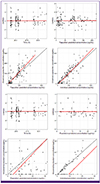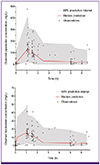1. Gin A, Dilay L, Karlowsky JA, Walkty A, Rubinstein E, Zhanel GG. Piperacilin-tazobactam: a beta-lactam/beta-lactamase inhibitor combination. Expert Rev Anti Infect Ther. 2007; 5:365–383.
2. Maltezou HC, Nikolaidis P, Lebesii E, Dimitriou L, Androulakakis E, Kafetzis DA. Piperacillin/tazobactam versus cefotaxime plus metronidazole for treatment of children with intra-abdominal infections requiring surgery. Eur J Clin Microbiol Infect Dis. 2001; 20:643–646.

3. Tumbarello M, Sanguinetti M, Montuori E, Trecarichi EM, Posteraro B, Fiori B, Citton R, D’Inzeo T, Fadda G, Cauda R, Spanu T. Predictors of mortality in patients with bloodstream infections caused by extended-spectrum-beta-lactamase-producing
Enterobacteriaceae: importance of inadequate initial antimicrobial treatment. Antimicrob Agents Chemother. 2007; 51:1987–1994.

4. Peralta G, Lamelo M, Alvarez-García P, Velasco M, Delgado A, Horcajada JP, Montero M, Roiz MP, Fariñas MC, Alonso J, Martínez LM, Gutiérrez-Macías A, Alava JA, Rodríguez A, Fleites A, Navarro V, Sirvent E, Capdevila JA; SEMI- BLEE STUDY GROUP. Impact of empirical treatment in extended-spectrum beta-lactamase-producing Escherichia coli and Klebsiella spp bacteremia. A multicentric cohort study. BMC Infect Dis. 2012; 12:245.
5. Turnidge JD. The pharmacodynamics of β-lactams. Clin Infect Dis. 1998; 27:10–22.

6. Mckinnon PS, Paladino JA, Schentag JJ. Evaluation of area under the inhibitory curve (AUIC) and time above the minimum inhibitory concentration (T>MIC) as predictors of outcome for cefepime and ceftazidime in serious bacterial infections. Int J Antimicrob Agents. 2008; 31:345–351.

7. Lodise TP, Lomaestro BM, Drusano GL; Society of Infectious Diseases Pharmacists. Application of antimicrobial pharmacodynamics concepts into clinical practice: focus onββ -lactam antibiotics: insights form the Society of Infectious Diseases Pharmacists. Pharmacotherapy. 2006; 26:1320–1332.

8. Patel N, Scheetz MH, Drusano GL, Lodise TP. Identification of optimal renal dosage adjustments for traditional and extended-infusion piperacillin-tazobactam dosing refimens in hospitalized patients. Antimicrob Agents Chemother. 2010; 54:460–465.

9. Dulhunty JM, Roberts JA, Davis JS, Webb SA, Bellomo R, Gomersall C, Shirwadkar C, Eastwood GM, Myburgh J, Paterson DL, Lipman J. Continous infusion of beta-lactam antibiotics in severe sepsis: a multicenter double-blind, randomized controlled trial. Clin Infect Dis. 2013; 56:236–244.

10. Roberts JA, Ulldemolins M, Roberts MS, McWhinney BC, Ungerer J, Paterson DL, Lipman J. Therapeutic drug monitoring of β-lactams in critically ill patients: proof of concept. Int J Antimicrob Agents. 2010; 36:332–339.

11. Johnson JA. Influence of race or ethnicity on pharmacokinetics of drugs. J Pharm Sci. 1997; 86:1328–1333.

12. Chen ML. Ethnic or racial differences revisited: impact of dosage regimen form on pharmacokinetics and pharmacodynamics. Clin Pharmacokinet. 2006; 45:957–964.
13. Jeon S, Han S, Lee J, Hong T, Paek J, Woo H, Yim DS. Population pharmacokinetic analysis of piperacillin in burn patients. Antimicrob Agents Chemother. 2014; 58:3744–3751.

14. Oh KH, Kim C, Lee H, Lee H, Jung JY, Kim NJ, Yu KS, Shin KH, Jang IJ, Ahn C. Pharmacokinetics of intravenous piperacillin administration in patients undergoing on-line hemodiafiltration. Antimicrob Agents Chemother. 2009; 53:3266–3268.

15. Kiem S, Ryu SM, Lee YM, Schentag JJ, Kim YW, Kim HK, Jang HJ, Joo YD, Jin K, Shin JG, Ghim JL. Population pharmacokinetics of levofloxacin in Korean patients. J Chemother. 2016; 28:308–313.

16. Li C, Kuti JL, Nightingale CH, Mansfield DL, Dana A, Nicolau DP. Population pharmacokinetics and pharmacodynamics of piperacillin/tazobactam in patients with complicated intra-abdominal infection. J Antimicrob Chemother. 2005; 56:388–395.

17. Felton TW, Roberts JA, Lodise TP, Guilder MV, Boselli E, Neely MN, Hope WW. Indivisualization of piperacillin dosing for critically ill patients: dosing software to optimize antimicrobial therapy. Antimicrob Agents Chemother. 2014; 58:4094–4102.

18. Hayashi Y, Roberts JA, Paterson DL, Lipman J. Pharmacokinetic evaluation of piperacillin-tazobactam. Expert Opin Drug Metab Toxicol. 2010; 6:1017–1031.

19. Cheymol G. Effects of obesity on pharmacokinetics implications for drug therapy. Clin Pharmacokinet. 2000; 39:215–231.
20. Morgan DJ, Bray KM. Lean body mass as a predictor of drug dosage. Implications for drug therapy. Clin Pharmacokinet. 1994; 26:292–307.
21. Cheatham SC, Fleming MR, Healy DP, Chung CE, Shea KM, Humphrey ML, Kays MB. Steady-state pharmacokinetics and pharmacodynamics of piperacillin and tazobactam administered by prolonged infusion in obese patients. Int J Antimicrob Agents. 2013; 41:52–56.

22. Chung EK, Cheatham SC, Fleming MR, Healy DP, Shea KM, Kays MB. Population pharmacokinetics and pharmacodynamics of piperacillin and tazobactam administered by prolonged infusion in obese and nonobese patients. J Clin Pharmacol. 2015; 55:899–908.

23. Tamma PD, Turnbull AE, Milstone AM, Hsu AJ, Carroll KC, Cosgrove SE. Does the piperacillin minimum inhibitory concentration for
Pseudomonas aeruginosa influence clinical outcomes of children with pseudomonal bacteremia? Clin Infect Dis. 2012; 55:799–806.

24. Karino F, Nishimura N, Ishihara N, Moriyama H, Miura K, Hamaguchi S, Sutani A, Kuraki T, Morikawa N. Nephrotoxicity induced by piperacillin-tazobactam in late elderly Japanese patients with nursing and healthcare associated pneumonia. Biol Pharm Bull. 2014; 37:1971–1976.

25. Huang WT, Hsu YJ, Chu PL, Lin SH. Neurotoxicity associated with standard doses of piperacillin in an elderly patient with renal failure. Infection. 2009; 37:374–376.









 PDF
PDF ePub
ePub Citation
Citation Print
Print



 XML Download
XML Download